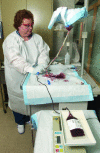Untying the Gordian knot: policies, practices, and ethical issues related to banking of umbilical cord blood
- PMID: 16200191
- PMCID: PMC1236704
- DOI: 10.1172/JCI26690
Untying the Gordian knot: policies, practices, and ethical issues related to banking of umbilical cord blood
Abstract
Since the first successful transplantation of umbilical cord blood in 1988, cord blood has become an important source of hematopoietic stem and progenitor cells for the treatment of blood and genetic disorders. Significant progress has been accompanied by challenges for scientists, ethicists, and health policy makers. With the recent recognition of the need for a national system for the collection, banking, distribution, and use of cord blood and the increasing focus on cord blood as an alternative to embryos as a source of tissue for regenerative medicine, cord blood has garnered significant attention. We review the development of cord blood banking and transplantation and then discuss the scientific and ethical issues influencing both established and investigational practices surrounding cord blood collection, banking, and use.
Figures

Similar articles
-
[Stem cells from cord blood: legal and ethical questions of transplantation and banking].Ther Umsch. 2002 Nov;59(11):583-7. doi: 10.1024/0040-5930.59.11.583. Ther Umsch. 2002. PMID: 12498050 German.
-
Ethical issues in umbilical cord blood banking: a comparative analysis of documents from national and international institutions.Transfusion. 2013 Apr;53(4):902-10. doi: 10.1111/j.1537-2995.2012.03824.x. Epub 2012 Jul 31. Transfusion. 2013. PMID: 22845856 Review.
-
Ethical issues relating the the banking of umbilical cord blood in Mexico.BMC Med Ethics. 2009 Aug 14;10:12. doi: 10.1186/1472-6939-10-12. BMC Med Ethics. 2009. PMID: 19678958 Free PMC article. Review.
-
Umbilical cord blood banks. Ethical aspects. Public versus private banks.Cuad Bioet. 2012 May-Aug;23(78):269-85. Cuad Bioet. 2012. PMID: 23130743
-
Umbilical cord blood banking in Canada: socio-ethical and legal issues.Health Law J. 2005;13:187-212. Health Law J. 2005. PMID: 17044327 No abstract available.
Cited by
-
Decreased Mortality in 1-Year Survivors of Umbilical Cord Blood Transplant vs. Matched Related or Matched Unrelated Donor Transplant in Patients with Hematologic Malignancies.Transplant Cell Ther. 2021 Aug;27(8):669.e1-669.e8. doi: 10.1016/j.jtct.2021.05.002. Epub 2021 May 12. Transplant Cell Ther. 2021. PMID: 33991725 Free PMC article.
-
Feasibility of autologous cord blood cells for infants with hypoxic-ischemic encephalopathy.J Pediatr. 2014 May;164(5):973-979.e1. doi: 10.1016/j.jpeds.2013.11.036. Epub 2013 Dec 31. J Pediatr. 2014. PMID: 24388332 Free PMC article. Clinical Trial.
-
Towards a richer debate on tissue engineering: a consideration on the basis of NEST-ethics.Sci Eng Ethics. 2013 Sep;19(3):963-81. doi: 10.1007/s11948-012-9419-y. Epub 2012 Nov 15. Sci Eng Ethics. 2013. PMID: 23229374
-
Cell sources proposed for nucleus pulposus regeneration.JOR Spine. 2021 Nov 24;4(4):e1175. doi: 10.1002/jsp2.1175. eCollection 2021 Dec. JOR Spine. 2021. PMID: 35005441 Free PMC article. Review.
-
Update on umbilical cord blood transplantation.Curr Opin Pediatr. 2009 Feb;21(1):22-9. doi: 10.1097/mop.0b013e32832130bc. Curr Opin Pediatr. 2009. PMID: 19253461 Free PMC article. Review.
References
-
- Gluckman E, et al. Hematopoietic reconstitution in a patient with Fanconi’s anemia by means of umbilical-cord blood from an HLA-identical sibling. N. Engl. J. Med. 1989;321:1174–1178. - PubMed
-
- Wagner JE, Kernan NA, Steinbuch M, Broxmeyer HE, Gluckman E. Allogeneic sibling umbilical-cord-blood transplantation in children with malignant and non-malignant disease. Lancet. 1995;346:214–219. - PubMed
-
- Kernan NA, et al. Analysis of 462 transplantations from unrelated donors facilitated by the National Marrow Donor Program. N. Engl. J. Med. 1993;328:593–602. - PubMed
-
- To LB, et al. Comparison of haematological recovery times and supportive care requirements of autologous recovery phase peripheral blood stem cell transplants, autologous bone marrow transplants, and allogeneic bone marrow transplants. Bone Marrow Transplant. 1992;9:277–284. - PubMed
-
- Drobyski WR, et al. Effect of T-cell depletion as graft-versus-host disease prophylaxis on engraftment, relapse, and disease-free survival in unrelated marrow transplantation for chronic myelogenous leukemia. Blood. 1994;83:1980–1987. - PubMed

